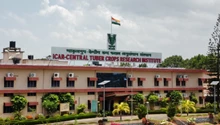
Punjab in terms of ‘farm incomes’ is expanding at a far slower rate than some typically poorer states, according to new statistics, which suggests that the state's agriculture has struck an unbreakable economic law: diminishing returns.
Punjab sparked India's Green Revolution five decades ago, saving millions of people from starvation. However, the benefits are rapidly fading. According to experts, the income slowdown is due to an over-dependence on large cereals like wheat and rice.
The Situation Assessment of Agricultural Households 2018-19 (SAS), a nationwide study of farm incomes released recently, shows that farm income growth is slowing in Punjab.
Despite the fact that Punjabi farmers have the highest absolute levels of monthly income in the country, agricultural income in the state rose 6.73 percent annually between 2013-14 and 2018-19, according to the study.
Farm earnings in states like Bihar and Uttarakhand, on the other hand, rose significantly faster, by 13.3% and 19.3%, respectively, during the same period, although over a low base.
Cheap fertilisers, guaranteed minimum support prices (MSPs) for cereals, free energy for water pumping, and high-yielding seedlings have fueled a trend of ‘mono-cropping,' or the practice of producing rice in the summer and wheat in the winter, throughout the decades. According to studies, this has robbed Punjab's farmers of potential revenue that could have come from producing a more diversified collection of crops.
The MSP, or minimum support price, is a government-set floor price. To develop stockpiles for redistribution to the needy, the government ‘procures' or buys rice and wheat at MSP. Farmers' dependence on grains has risen as a result of this.
Farmers have been opposing the Modi government's three new farm laws since last year, and protesting cultivators have demanded a formal guarantee for MSP, prompting authorities to increase grain purchase even further.
In 2020, the government purchased a record 60.06 million tons of rice cultivated during the summer-sown kharif season, the biggest amount ever purchased.
Punjab's rich landscape of corn, barley, gram, lentils, and nutritious coarser grains vanished within a decade of big cereals entering the province in the late 1960s, thanks to this procurement strategy, which incentivises big cereals.
According to data quoted in a recent article by Prof. Surinder S. Jodhka of Jawaharlal Nehru University, New Delhi, the number of crops cultivated by Punjabi farmers has decreased from 21 in the 1960s to only about nine now.
“The Green Revolution was a Brown Revolution disguised as a Green Revolution. It was only rice and wheat,” remarked Uma Kapila, an economist who used to teach at Miranda House in Delhi.
According to economists Ashok Gulati and Siraj Hussain of the think-tank ICRIER, Punjab's average agricultural gross domestic output has plateaued at 2%, despite the fact that it might have increased by more than 5% yearly if farmers had not given up farming a more diversified collection of crops.
Gulati's study reveals that between 2005-06 and 2014-15, the state's agricultural GDP, a broad gauge of farm revenue, rose just 1.61 percent yearly, less than half the all-India average of 3.5 percent.
Farmers set fire to paddy-crop debris, known as stubble, to clear fields, which is contributing to a severe winter haze throughout most of northern India.
Punjab requires 5,500 litres of water to cultivate one kilogram of rice, which is five times more than China, indicating the state's low water productivity. Water scarcity is severe in the northern and central districts, while water logging and soil salinity or alkalinity are problems in the south-western districts.
Muktsar, Fazilka, Bathinda, and Faridkot are notably degraded districts. In May of last year, the Central Ground Water Board issued a grave warning: if present water extraction rates continue, Punjab would become a desert within the next quarter-century.
According to KS Mani, a former faculty member at the Tamil Nadu Agricultural University, “the state has never been able to achieve an agenda of crop diversification initially laid out by the so-called S.S. Johl committee in 1986.”
According to Balwinder Singh Sandhu, the state's agricultural commissioner, big cereals have sparked an insidious rise in expenses, with yearly increases of 5-6 percent driving farmers into debt.
When a measure of cultivation called "C2 cost" is included in, which includes the imputed rental value of land, depreciation, and interest on capital, the increase in paddy MSP has barely kept pace with growing expenses.
Growth requires an increase in the percentage of capital, such as mechanized harvesters and investment. However, without technical improvements, infusing more and more capital might lead to what Nobel Laureate economist Robert Solow described as a "steady economic state," in which all new investment is used to replace depleted capital with no productivity increases. As a result, the economy grinds to a halt.
The Green Revolution has run its course, and Punjab's agriculture is in the midst of a similar standstill. Sandhu wonders, "Why are 1.5 lakh individuals going overseas every year?"











